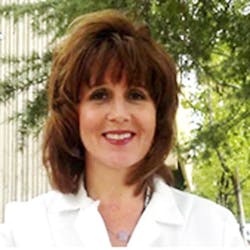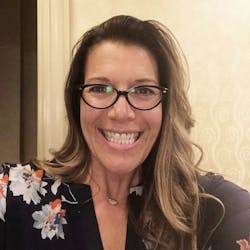The COVID-19 pandemic crashed into the world like tidal waves in a storm with catastrophic effects on the global healthcare, economic and cultural systems. Infections and deaths surged in communities, dampened lives and overwhelmed healthcare. As the pandemic now seems to be subsiding in some aspects and areas, it still remains vital to help protect populations from transmission and contraction of SARS-CoV-2.
Consequently, COVID-19 boosted concentration on surface cleaning and personal hygiene at home, in hospitals and other workplaces, as well as in public spaces. Environmental Services (EVS) staff answer this call performing essential cleaning and sanitization in patient care settings.
“EVS teams have always played an integral role in cleaning and disinfection in healthcare facilities,” emphasized Julie Stegeman, IIDA, NCIDQ, LEED AP ID+C, Healthcare Segment Manager, Interface. “They are frontline defenders when it comes to contamination control. The ongoing COVID-19 crisis elevated the role of these EVS teams practically overnight. At the same time, it made their roles more complex as they adapted to changing best practices surrounding transmission prevention, social distancing and more.”
As the second year of the pandemic persists, ongoing cleaning, hygiene, health and safety actions are expected to continue, according to the American Cleaning Institute (ACI), which serves as the Home of the U.S. Cleaning Products Industry.
“A national online consumer survey conducted by Ipsos on behalf of ACI shows that 85% of respondents are very or somewhat likely to maintain the same level of cleaning practices initially adopted in March 2020, even when the pandemic has passed,”1 reported ACI.
“In today’s current climate, as schools and communities across the country begin to reopen and new variants of the virus continue to spread, the cleaning and hygiene habits adopted at the onset of the pandemic will continue to play a crucial role in helping prevent the spread of illness,” ACI stated.
“Key findings include:
• Of the adopted cleaning, disinfecting and hygiene habits, Americans report an increase in use of the following products since the pandemic began in March 2020: hand sanitizer (72% versus 59%), disinfectant wipes (55% versus 44%) and spray disinfectant (42% versus 36%).
• More than 75% of respondents plan to continue to wash their hands frequently with soap and water and 57% report plans to continue using hand sanitizer frequently in the future.
• 73% of Americans cite protecting their own health and wellness, and 62% cite protecting that of others, as reasons to continue their COVID-19 cleaning habits.”1
With regard to hand hygiene, healthcare and other industries have significantly ramped up their supply of hand sanitizers, according to a survey in April by GP PRO, a division of Georgia-Pacific.2
The survey, “found that the number of hand sanitizer units in foodservice, healthcare, industrial, lodging, and office facilities nearly doubled since the start of the coronavirus pandemic, increasing from an average of 23 units to more than 40 units per facility. The greatest increase occurred in office facilities, with the average number of units tripling, but the highest number of total units occurred in healthcare and lodging facilities, with each averaging 85 per facility.”
Additionally, the company reported that, “Hand sanitizer units increased by more than 50% on average in healthcare facilities. Post-pandemic, 91% of healthcare respondents expect to leave most or all of their hand sanitizer units in place.”
EVS on deck with facility safety
Hospital, medical and other places of patient care must continue to follow the highest standards and protocols of room and surface cleaning and disinfection to help control the transmission of healthcare-associated infections (HAIs), including COVID-19. EVS workers step up daily to provide these critical practices and protection to help achieve hygienic and safe settings.
“EVS teams save patient lives every day by maintaining the complex clinical environment of care,” Kley emphasized. “Experts believe that the SARS-CoV-2 virus, the virus responsible for the pandemic, will likely become endemic and seasonal. EVS teams must ensure that their facilities have EPA-approved disinfectants appropriate, not only for SARS-CoV-2, but also for other targeted healthcare pathogens. They must ensure that instructions for use, including contact time, are followed. Simply put, the key role of EVS is to eliminate the environment as a source of infection.”
The Centers for Disease Control and Prevention (CDC) serves as a go-to source for guidance on SARS-CoV-2, COVID-19 and environmental cleaning.
Last year, the CDC “released a new resource highlighting core components of environmental cleaning disinfection in hospitals. The document aims to help healthcare organizations reduce risk of infection from surfaces and provides descriptions and examples of each of the six core components in order to ensure a clean patient care environment. AHA’s Association for the Health Care Environment (AHE) played a significant role in the development of the core components of an environmental services program in hospitals within this guidance,”2 reported the American Hospital Association (AHA).
Among the CDC-recommended best practices for environmental cleaning are, “Environmental cleaning programs in healthcare facilities involve resources and engagement from multiple stakeholders and departments, such as administration, infection prevention and control (IPC), water, sanitation, and hygiene (WASH), and facilities management. They require a standardized and multi-modal approach, as well as strong management and oversight, to be implemented effectively…Comprehensive environmental cleaning programs are most important at acute healthcare facilities and higher tiers of healthcare, where the burden of HAIs is highest. Regardless of type of facility, the key program elements for effective environmental cleaning programs include:
• organization/administration
• staffing and training
• infrastructure and supplies
• policies and procedures
• monitoring, feedback and audit.”3
“EVS have always played an essential role in helping hospitals and healthcare facilities sustain high hygiene standards,” reinforced Deborah Chung, North America Marketing Manager, Healthcare – Professional Hygiene, Essity. “Frequent and routine surface cleaning (especially of high-touch areas) mitigates the spread of HAIs and cross-contamination within healthcare facilities and this responsibility is placed largely on EVS teams.”
Partners in infection prevention
Like shipmates at sea, EVS and infection prevention (IP) staff are on board to direct practices for cleaner and safer facilities.
“Effective communication and collaboration between EVS directors, facility managers and/or infection preventionists is integral to the successful implementation of established cleaning and disinfection guidelines, processes, protocols and best practices,” shared Rushworth of Rubbermaid Commercial Products. “Ultimately, EVS and infection preventionists are partners in prevention by working towards the same goal: enhanced patient safety and delivery of quality services.”
“One of the most important responsibilities for EVS staff is the effective application of cleaning products, including disinfecting products, which could mean the difference between acquiring COVID or another HAI,” Hoffmann noted. “Education and training using evidence-based guidelines (e.g., Centers for Disease Control and Prevention) are keys to the success of the EVS program. With the recognition of the importance of a clean environment to prevent cross transmission of pathogens, like C. difficile and multi-drug resistant organisms, infection preventionists and EVS leadership began to work together to provide routine training, auditing, checklists and feedback to the front-line EVS workers. IP and EVS rounding together in the facility provide additional opportunities for communication and reinforcing policy and procedures.”
Interface’s Stegeman notes the value of vendor and IP support.
“A critical first step is selecting vendor partners that offer continual, structured education and training programs,” she emphasized. “At the same time, EVS teams must have buy-in from leadership in terms of the need for continual access to resources for infection prevention. Implementing consistent maintenance protocols is an important consideration for EVS and Infection Prevention teams.”
Regarding education, the CDC recommends, “Training content should include, at a minimum:
• general introduction to the principles of IPC, including transmission of pathogens; the key role cleaning staff play in keeping patients, staff and visitors safe; how cleaning staff can protect themselves from pathogens
• detailed review of the specific environmental cleaning tasks for which they are responsible, including review of SOPs, checklists, and other job aids
• when and how to safely prepare and use different detergents, disinfectants, and cleaning solutions
• how to prepare, use, reprocess, and store cleaning supplies and equipment (including PPE)
• participatory training methods, hands-on component with demonstration and practice
• easy-to-use visual reminders that show the cleaning procedures (i.e., without the need for a lot of reading)
• orientation to the facility layout and key areas for the cleaning program (e.g., environmental cleaning services areas)
• other health and safety aspects, as appropriate.”3
“Environmental Services teams display leadership everyday tirelessly performing some of the toughest jobs in healthcare facilities – all to protect patients and fellow staff by providing a cleaner, safer environment,” Steely said. “These brave women and men are also true innovators – bringing a solutions-first mindset to breakthrough resource and/or time constraints. This ingenuity is pioneering best practices that will outlast the pandemic. It’s truly inspiring.”
David St. Clair, Chairman and CFO, Halosil International, points to changes in practices made by EVS and IP teams to help decrease COVID-19 spread.
“The COVID-19 pandemic challenged EVS and IP teams to enact higher standards across healthcare facilities for preventing the spread of infection,” St. Clair expressed. “These actions ranged from policy changes pertaining to mandatory mask wearing and limited visitors to implementing more rigorous disinfection practices. When it comes to disinfection, in the past IP and EVS teams held disinfectants on the EPA’s List K of products with a sporicidal kill claim against C. difficile as the golden standard. During the pandemic, they turned to List N for products that meet the EPA’s criteria for use against SARS-CoV-2.”
As the crisis starts to lighten, Kley of Clorox Professional Products Co. recommends EVS teams revisit prior training and education on all infectious pathogens.
“With the pandemic showing signs of slowing and as we start to get back to the ‘new’ normal, now is the time to hit the reset button and get back to basics,” she stressed. “For the past 17 months, a lot of attention has been focused on a single pathogen. During refresher trainings, it’s important to remind EVS teams that there are other equally important pathogens like C. difficile and AROs. A key component of training programs is competency assessment, which tests both skill and knowledge. This can be accomplished through return-demonstrations, direct observation, quizzes or any combination of these.”
Navigating future course of EVS
How can EVS teams prepare for what comes next in healthcare facility cleaning and disinfection?
Halden Shane, DPM, Chief Executive Officer and Chief Scientific Officer, TOMI Environmental Solutions, predicts continued adaptability and support needed among EVS and IP departments.
“While IP specialists and EVS technicians have always required an incredible level of foresight to anticipate new pathogenic threats and patterns within healthcare facilities, the ongoing pandemic has added significant levels of risk, uncertainty and urgency,” Shane explained. “We may be facing a relatively new viral threat, but other known and existing pathogens – and potentially lethal ones – are still very much present across the globe. Just as cleaning (EVS) and IP teams need added flexibility during these times, they also need solutions that can broadly help, no matter how our understanding of these threats evolves.”
Alice Brewer, MPH, CIC, CPHQ, FAPIC, Clinical Affairs Director, Tru-D SmartUVC, part of PDI Healthcare, recommends creating professional development and communication opportunities for teams.
“The most important thing EVS and IP teams can do to be prepared in the future is to maintain their current competencies and be aware of any new guidelines and recommendations,” Brewer stated. “Keeping good lines of communication with other departments, such as nursing, sterile processing and pharmacy, will also ensure that they are prepared for whatever challenges are ahead.”
Staying up to date with practices and products in the field also will be key to moving forward, envisions Hoffmann of Vidashield UV24.
“Well established EVS protocols have been a saving grace in healthcare operations,” she said. “With or without COVID, what is not going to change is the need to provide a clean environment for patient and healthcare worker safety. EVS will need to be front and center to help healthcare facilities in evaluating new processes and technologies for environmental cleaning and disinfection.”
EVS-Facilities Management Resource Guide
References:
1. ACI Survey: 85% of Americans to Keep Up Cleaning Practices After COVID, https://www.cleaninginstitute.org/newsroom/releases/2021/aci-survey-85-americans-keep-cleaning-practices-after-covid1
2. Growth in Hand Sanitizer Units Expected to Outlast COVID, https://www.gppro.com/gp/news-and-knowledge/growth-in-hand-sanitizer-units-expected-to-outlast-covid
3. CDC releases cleaning resource for health care environment, https://www.aha.org/news/headline/2020-11-02-cdc-releases-cleaning-resource-health-care-environment
4. CDC and ICAN. Best Practices for Environmental Cleaning in Healthcare Facilities in Resource-Limited Settings. Atlanta, GA: US Department of Health and Human Services, CDC; Cape Town, South Africa: Infection Control Africa Network; 2019, https://www.cdc.gov/hai/prevent/resource-limited/index.html, http://www.icanetwork.co.za/icanguideline2019/3
Achieving healthcare environment hygiene success
What are the latest environmental cleaning and disinfection tools, technology and practices used to decrease pathogens in healthcare facilities and improve safety in patient care?
 The Tork Interactive Clean Hospital Training“As we continue to mitigate the spread of new COVID-19 strains and HAIs, EVS contributions must remain a priority for management, as the focus on facility cleanliness and hygiene is a key contributor to overall success. Digital training platforms, like Tork Interactive Clean Hospital Training, alongside refreshed tools, can help EVS teams feel more engaged and empowered to achieve excellent hygiene results with the understanding that their roles are fundamental to patient, visitor and staff safety. Investing in products and solutions that are specifically designed for EVS teams will also ensure sustained hygiene compliance. Tork Microfiber Cleaning Cloths pick up dirt and microorganisms – instead of just pushing them around – and because they are color coded it is easier for staff to assign a wiper to a specific task.
The Tork Interactive Clean Hospital Training“As we continue to mitigate the spread of new COVID-19 strains and HAIs, EVS contributions must remain a priority for management, as the focus on facility cleanliness and hygiene is a key contributor to overall success. Digital training platforms, like Tork Interactive Clean Hospital Training, alongside refreshed tools, can help EVS teams feel more engaged and empowered to achieve excellent hygiene results with the understanding that their roles are fundamental to patient, visitor and staff safety. Investing in products and solutions that are specifically designed for EVS teams will also ensure sustained hygiene compliance. Tork Microfiber Cleaning Cloths pick up dirt and microorganisms – instead of just pushing them around – and because they are color coded it is easier for staff to assign a wiper to a specific task.
“To ensure consistency, EVS managers should provide a facility-wide checklist that establishes protocol for surface cleaning, along with precisely what should be disinfected and the required frequency of cleaning for each of these areas.
Deborah Chung, Essity
 NUVO Surgical’s Vidashield UV24“One technology that CDC recommends facilities who can’t meet the increased ventilation standards use is upper room ultraviolet germicidal irradiation (UVGI). Vidashield UV24 is an upper room UVGI that has demonstrated in multiple studies statistically significant reductions in air and surface contamination of aerosolized bacteria, viruses, and fungi.”
NUVO Surgical’s Vidashield UV24“One technology that CDC recommends facilities who can’t meet the increased ventilation standards use is upper room ultraviolet germicidal irradiation (UVGI). Vidashield UV24 is an upper room UVGI that has demonstrated in multiple studies statistically significant reductions in air and surface contamination of aerosolized bacteria, viruses, and fungi.”
Karen Hoffmann, NUVO Surgical
 HaloFogger and HaloMist“Halosil’s EVS and IP customers have slowed the spread of disease by utilizing the Halo Disinfection System to reach pathogens in all the cracks and crevices where they lurk. The system pairs HaloMist disinfectant (EPA Reg. No. 84526-6) with the HaloFogger equipment to ensure a uniform delivery of our disinfectant throughout complex spaces. Today, the Halo system is the whole room disinfection solution of choice for hospitals, long-term care facilities and surgical centers worldwide. In particular, during the COVID-19 crisis, our system has been an integral part of routine cleaning in rooms on COVID floors of hospitals and for ambulances and other emergency transport vehicles that have been exposed to potentially COVID-positive patients.”
HaloFogger and HaloMist“Halosil’s EVS and IP customers have slowed the spread of disease by utilizing the Halo Disinfection System to reach pathogens in all the cracks and crevices where they lurk. The system pairs HaloMist disinfectant (EPA Reg. No. 84526-6) with the HaloFogger equipment to ensure a uniform delivery of our disinfectant throughout complex spaces. Today, the Halo system is the whole room disinfection solution of choice for hospitals, long-term care facilities and surgical centers worldwide. In particular, during the COVID-19 crisis, our system has been an integral part of routine cleaning in rooms on COVID floors of hospitals and for ambulances and other emergency transport vehicles that have been exposed to potentially COVID-positive patients.”
David St. Clair, Halosil International
 TOMI’s SteraMist“During the early stages of the pandemic, multiple customers quickly disinfected emergency treatment (Surge) tents at several locations with minimal staff and quick turnover, and now are using SteraMist to disinfect vaccine spaces. The Pfizer facility creating the coronavirus Pfizer-BioNTech vaccine uses a SteraMist Custom Engineered System (CES) to decontaminate their cleanrooms with 20 SteraMist applicators throughout four cleanrooms. Both our surface and environment unit were used successfully for the reprocessing of tens of thousands of N95 masks at various well-known academic healthcare facilities around the United States for data submission to the FDA.
TOMI’s SteraMist“During the early stages of the pandemic, multiple customers quickly disinfected emergency treatment (Surge) tents at several locations with minimal staff and quick turnover, and now are using SteraMist to disinfect vaccine spaces. The Pfizer facility creating the coronavirus Pfizer-BioNTech vaccine uses a SteraMist Custom Engineered System (CES) to decontaminate their cleanrooms with 20 SteraMist applicators throughout four cleanrooms. Both our surface and environment unit were used successfully for the reprocessing of tens of thousands of N95 masks at various well-known academic healthcare facilities around the United States for data submission to the FDA.
“‘The Total SteraMist Disinfection Cart has been very easy to use on every surface and the technology kills a wide variety of pathogens. We use SteraMist disinfection in our ER isolation rooms and for COVID-19 patient rooms,’
– Kyle Swanger, Director of Environmental Services, St. Luke’s Medical Center.
‘Since implementing SteraMist, MorseLife’s number of COVID, C. diff and general flu cases have been lowered. SteraMist has provided all of the healthcare employees, patients and family members with confidence and peace of mind with deeply disinfected environments.’
– Stephen Shell, Risk Manager, MorseLife Health System.”
Dr. Halden Shane, TOMI Environmental Solutions
 Tru-D SmartUVC – a PDI Solution“EVS and IP teams have shifted the way they use Tru-D SmartUVC in order to combat SARS-CoV-2. More attention is being paid to mobile devices or those that are used on multiple patients, like blood pressure cuffs and stethoscopes. There has also been increased focus on areas that previously were not considered priority targets for no-touch disinfection, such as public bathrooms and staff work areas.”
Tru-D SmartUVC – a PDI Solution“EVS and IP teams have shifted the way they use Tru-D SmartUVC in order to combat SARS-CoV-2. More attention is being paid to mobile devices or those that are used on multiple patients, like blood pressure cuffs and stethoscopes. There has also been increased focus on areas that previously were not considered priority targets for no-touch disinfection, such as public bathrooms and staff work areas.”
Alice Brewer, Tru-D SmartUVC
 Solaris Robots’ Lytbot 1.0“Our customers have responded by increasing PPE, physically distancing and running their Lytbots after every discharge and isolation to ensure pathogen eradication. One client, St. Tammany Health System, takes a reading on pathogen load in a room before and after manual cleaning and again after UV disinfection with the Lytbot; this ensures accuracy in reporting and helps to maintain their very low infection rates. A hospital of their size is expected to have 30 cases of C. diff per year, but due to their robust disinfection protocols, they only see around seven; this amounts to 78% fewer cases than expected for their facility class.”
Solaris Robots’ Lytbot 1.0“Our customers have responded by increasing PPE, physically distancing and running their Lytbots after every discharge and isolation to ensure pathogen eradication. One client, St. Tammany Health System, takes a reading on pathogen load in a room before and after manual cleaning and again after UV disinfection with the Lytbot; this ensures accuracy in reporting and helps to maintain their very low infection rates. A hospital of their size is expected to have 30 cases of C. diff per year, but due to their robust disinfection protocols, they only see around seven; this amounts to 78% fewer cases than expected for their facility class.”
Adam Steinhoff, Co-founder, CEO, Solaris Robots
“The past year has shown us the true value of EVS teams and uncovered some of the inefficiencies in environmental disinfection within healthcare facilities. In addition to utilizing standard cleaning and disinfecting methods and products, such as our Clorox Healthcare portfolio of manual disinfectants, technological advancements, like electrostatic technology, can help in keeping both patient and public spaces safe and healthy. At CloroxPro, we offer a portfolio of electrostatic devices paired with EPA-approved chemistries. Electrostatic devices are engineered to disinfect areas more quickly and efficiently throughout a healthcare facility.”
Doe Kley, Clorox Professional Products Co.
“Continuously looking into improving the efficiency and quality of cleaning and disinfection practices is key to enhancing patient safety both now and as facilities plan for the future. This can be accomplished by investing in innovative products, such as our HYGEN microfiber, proven to remove 99.7 % or more of tested microorganisms with water alone, including C. diff and MRSA*, coupled with adjunct technologies, such as UVC or dry hydrogen peroxide that support standard cleaning and disinfection.”
*Based on third party testing with water only on VCT surface. Tested Virus: Feline Calicivirus (substitute for Human Norovirus), common human coronavirus OC43. Tested Bateria: Clostridioides difficile (C. diff), methicillin-resistant Staphylococcus aureus (MRSA), Pseudomonas aeruginosa. Not tested on COVID-19.
Andrew Rushworth, Rubbermaid Commercial Products
“Continual knowledge sharing around product and technology innovations and best practices among EVS leadership across health systems is the most effective way to proactively address infection control. Interface offers a full suite of flooring options – carpet tile, LVT, nora rubber flooring and now vinyl sheet – to meet the specific needs and requirements of healthcare facilities.”
Julie Stegeman, Interface
 nora flooring from Interface
nora flooring from Interface
 UVDI-360“To drive environmental hygiene best practices, our frontline partners are increasingly relying on digital resources. One way UVDI supports this is with the advanced SmartData portal built into the UVDI-360 Room Sanitizer; it can store key details for any room disinfection protocol, including room location, device operator and disinfection cycle length. The UVDI-360 is a lightweight device easily maneuvered to potentially high-risk areas across a facility – where it provides rapid UV-C room disinfection in five to 10 minutes. Our Environmental Services partners are increasingly standardizing enhanced environmental hygiene – not only in patient rooms for terminal cleaning, but also in operating rooms, isolation rooms, ICUs, Labor and Delivery, the Emergency Department, Hematology/Oncology and many more sites.”
UVDI-360“To drive environmental hygiene best practices, our frontline partners are increasingly relying on digital resources. One way UVDI supports this is with the advanced SmartData portal built into the UVDI-360 Room Sanitizer; it can store key details for any room disinfection protocol, including room location, device operator and disinfection cycle length. The UVDI-360 is a lightweight device easily maneuvered to potentially high-risk areas across a facility – where it provides rapid UV-C room disinfection in five to 10 minutes. Our Environmental Services partners are increasingly standardizing enhanced environmental hygiene – not only in patient rooms for terminal cleaning, but also in operating rooms, isolation rooms, ICUs, Labor and Delivery, the Emergency Department, Hematology/Oncology and many more sites.”
Kristine Steely, UVDI
About the Author

Ebony Smith
Ebony Smith was previously Managing Editor for Healthcare Purchasing News.




